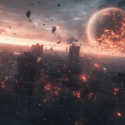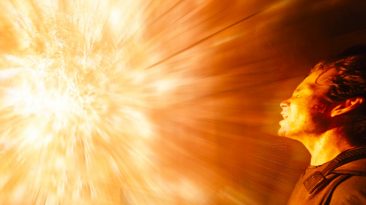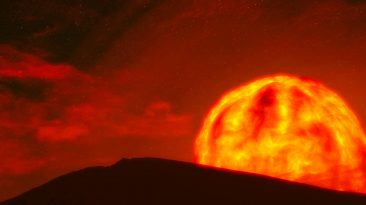Black holes are dark, matter-devouring balls of gravity. Most of them are so far away that we don’t need to worry about them. But not this one. Meet Gaia BH1. This enormous black hole sits right outside our Solar System. More specifically, 1,600 light-years away from us. Now, that might sound like a huge distance. But it’s way closer than any other black hole on record. What’s worse, we didn’t know about it until now.
Despite Gaia BH1 being 10 times more massive than our Sun, we couldn’t see it. Scientists usually discover these monstrosities by spotting the gas that a black hole feeds on. These hungry giants are called feeding black holes. Only Gaia BH1 isn’t anything like that. This black hole is dormant. It hides in the darkness, patiently waiting for the galaxy to throw it some cosmic matter to feast on. But there’s one thing that gave away Gaia’s presence. You see, most star systems in the Universe are binary. That means that they have not one, but two stars orbiting each other. Our black hole neighbor is also part of a binary star system. Except instead of two stars, this system has one star and one black hole. Yeah, Gaia BH1 was disguising itself as a star. Even though this monstrosity doesn’t feed on any gas or matter yet, it still couldn’t help jiggling its star counterpart a little. Good try, Gaia, but we still caught you.
Out there in space, there are black holes a lot scarier than Gaia BH1. Some are so bizarre that they shouldn’t even exist. A team of scientists discovered an unbelievable black hole and gave it the melodic name LB-1. The weird thing about this black hole is that it’s just too massive to be true. OK, let’s get some facts straight. We know of two types of black holes. Stellar black holes are what massive stars become when they die. They are everywhere in the Universe. Even in our Milky Way galaxy, there could be as many as one billion of them lurking around. These beasts can be between 10 and 24 times as massive as our Sun.
The other type of black holes are supermassive ones. These enormities sit at the center of almost every galaxy, including our own. We don’t really know how they form, but we do know that they are unimaginably gigantic. Billions of times more massive than our Sun. But LB-1 doesn’t fit either of these types. At 70 solar masses, it’s too enormous to be a stellar black hole, yet it’s too tiny to be a supermassive one. Scientists were scratching their heads trying to explain this phenomenon. Some theorized that it might not be a single black hole, but two black holes orbiting each other. Others guessed that LB-1 was born of a gigantic star that was still in the middle of becoming a black hole. The answer was simpler than we thought. LB-1 isn’t a black hole at all. It’s an optical illusion caused by two rare stars orbiting each other. It’s a unique star system to stargaze. But when scientists said they found an improbable black hole, they were wrong. But, please, how could you blame them? It’s hard to study an object 15,000 light-years away. Mistakes happen. The good news is that LB-1 didn’t upend our understanding of black holes after all.
Now, that doesn’t mean black holes can’t blow your mind. Remember the one at the center of the Milky Way? It’s called Sagittarius A*. It’s as massive as 4.5 million Suns. But there’s always a bigger fish in the Universe. Sagittarius A* might be the most massive monster lurking in our galaxy, but it’s not even close to some really big players out there. Like TON 618. This black hole is devouring matter 10 billion light-years away from us. It is as bright as 140 trillion Suns, so bright that it outshines its own galaxy. And its mass? 66 billion times that of our Sun. That’s right, 66 BILLION. TON 618 is horrifyingly big. When scientists discovered it, they began to wonder if even more massive black holes were possible. Of course, the name ‘supermassive’ wouldn’t do bigger black holes any justice. So astronomers came up with a cool name for them too. Stupendously Large Black Holes, or SLABs.
And then, they found one. Move over, TON 618, there’s a new gargantuan black hole in town. This stupendously large monstrosity sits at the center of Phoenix A galaxy around 8.5 billion light-years away from us. It’s almost impossible to imagine just how enormous this thing is. Scientists think it has a mass of 100 billion Suns. That’s more massive than some galaxies out there. And it won’t stop growing. The event horizon of this black hole at the center of Phoenix A is unimaginably huge, too. It has a diameter of about 100 times the distance between the Sun and Pluto. If you jumped on SpaceX Starship and tried to fly across this black hole, it would take you 2,500 years to complete that journey.
We’re lucky this monstrous SLAB is so far away from us that we don’t have to worry about it swallowing our Solar System whole. But there are two more supermassive black holes very close to Earth. And they’re on a collision course with each other. OK, when I say very close to Earth, I mean 500 million light-years away from us. Still, closer than many other scary things out there.
Seriously though, we don’t know exactly what happens when two supermassive black holes collide. We’ve never observed a full merger of supermassive giants. Scientists think that they’ll dance around each other for about 200 million years before finally becoming one. But this would be a violent marriage. As the black holes spiral together, they’ll send enormous gravitational waves through space. Waves could be so big that we will be able to detect them from our planetary neighborhood. But that’s not the scary part. Mergers like that happen all the time. And right now, the Milky Way is on a collision course with the Andromeda galaxy. When these two galaxies become one, what will happen to the supermassive black holes at their centers? Will they merge too? Would an event like this tear everything in its vicinity to shreds? I bet that’s what keeps astronomers up at night.
Sources
- Closest black hole is in our cosmic backyard. Anderson, P S (2022). Earth Sky.
- Astronomers discover closest known black hole to Earth, Gaia BH1. Lincoln, D (2022). Big Think.
- Astronomers May Have Just Discovered Our Sun’s Long-Lost Identical Twin. Starr, M (2018). Science Alert.
- Scientists find ‘monster’ black hole so big they didn’t think it was possible. Mettler, K (2019). The Washington Post.
- Black Holes. Nasa (2021). Nasa Science: Share The Science.



























